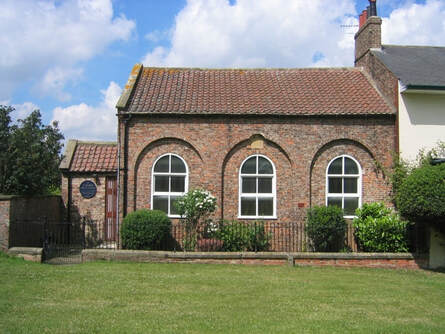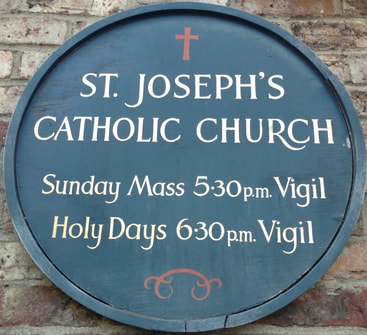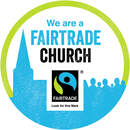Now closed: St. Joseph's Catholic Church, Green Hammerton
Overview
A former Methodist Church, St. Joseph's in the village of Green Hammerton (just off the A59 between York and Harrogate) was a Chapel of Ease (Mass centre) served by the pastoral team of Our Lady's, Acomb. In 2022 the diocese made the difficult decision to close St. Joseph's as it no longer met the requirements of health and safety.
A little history of St. Joseph's
Nestling on the west side of the village green at Green Hammerton is St. Joseph's Church, from 1961 until 2022 a 'chapel of ease' to Our Lady's Church in Acomb (a 'chapel of ease' being a church building other than the main parish church, built within the bounds of a parish for the attendance of those who cannot reach the parish church conveniently; also sometimes called a 'Mass station').
Every Saturday at 5.30pm about fifty parishioners from a wide rural area used to gather to celebrate the Eucharist (Mass).
Why was there a chapel at Green Hammerton?
The ultimate reason is that in the seventeenth and eighteenth centuries, Catholic Christianity was still alive in small Recusant communities among the villages along the River Ouse in this area. Since the English Reformation these Catholics had remained loyal to the pope and did not attend Church of England services. They had suffered many penalties for their faith, which was often lived out in secret, but the Catholic Emancipation movement in the late-eighteenth and early-nineteenth centuries allowed Catholics greater freedom and visibility. After the Catholic Emancipation Act in 1829, various arrangements were made to provide religious services for Catholics in Yorkshire.
In 1870 a Catholic chapel was built by Canon Robert Thompson in Nun Monkton, the next-door village to Green Hammerton. It was small, but could hold 150 people. Nun Monkton was selected because a ferry (long since shut down) meant that it linked villages on both sides of the Rivers Nidd and Ouse. The presence of a Catholic priest in the village made quite an impression on the people of Nun Monkton. The late Reg Burton, a Nun Monkton inhabitant, remembered how the children of the village would watch the Catholic parish priest smoking his pipe by the presbytery.
However, around World War II the ferry was shut, Nun Monkton became a backwater, and the parish church was attended by only a few Catholics. In 1949 the chapel was shut and later demolished, and for just over a decade Mass was held in the Reading Room in Green Hammerton, still standing near the village post office. The parish effectively become one only for Catholics living on the west bank of the River Ouse.
In 1954 the parish of Our Lady's was established in Acomb, a growing suburb to the west of York (click here for an overview of the parish's history). In 1956 Green Hammerton became part of Our Lady's parish, extending its area to nearly 200 square miles. The first parish priest of Our Lady's, Father Edward Ward, decided in 1960 to find a site for a new chapel of ease for the Catholics living in the large rural area between Acomb and Knaresborough/Harrogate. Private car ownership was still rare in the 1960s, and many Catholics found it hard to make the journey to Acomb. The following year the parish purchased the former Congregational church in Green Hammerton, originally built as a Methodist Chapel in the late 1790s. The chapel and the graveyard behind it are both historically significant and listed.
Buying and converting the chapel cost several hundred pounds, considered a large sum in those days, and much of it was raised by the parish itself. Parishioners organised whist drives, raffles, socials, and sales. The 1960s was to be a decade of changes in style, both in buildings and in worship; the chapel was purchased on the eve of the Second Vatican Council (1962-65). The architect Derek Walker redesigned the interior of the church in a fashion which owed little to either its non-conformist past or earlier Catholic styles. It was designed to have an east-west orientation (later changed by vote of parishioners to a north-south orientation) with a simple table serving as an altar against vertical slats of brown varnished wood under a black ceiling. The only statue, originally, was one of St. Joseph taken from the Nun Monkton church and placed at the back. The wooden panels were originally matched by chairs, intended to give a sense of community meeting in the spirit encouraged by the Second Vatican Council. The chairs were later replaced, after another vote, by traditional pew benches taken from the former Catholic chapel of ease at Minskip when it was closed, the transfer paid for by anonymous donors in the parish. A room at the back was used for socials and whist drives, but was eventually sold. Even in its reoriented form and with pews, the church conveyed very well the hopeful spirit of innovation and lightness which characterised English Catholicism in the early 1960s at the time of the Council. Walker's designs were deliberately intended to be cost-effective for many of the materials, and much of the work was done by local people.
On 20th August 1961, the Right Reverend George Dwyer (Bishop of Leeds, as the parish was in Leeds Diocese at that time) consecrated the newly refurbished church, and it was opened for services.
Whether on the dark evenings of winter, or the long light days of summer, worship at St. Joseph's Green Hammerton is a moving experience because the church has such a strong local and rural feeling in contrast to the urban setting of most Catholic churches in England. In the informal setting of St. Joseph's, priest and people pray and worship together in closer proximity than in a large building. A chapel of ease does not have the institutional underpinning or social programme of an urban church, but perhaps the proximity of priest and people compensates for some of that.
Certainly a long succession of parish priests since 1961 have got to know the people of St. Joseph's well, and appreciate the strong commitment that have to the Mass centre.
Any mention of St. Joseph's and its history would be incomplete if it did not mention the role of the Allen family of Green Hammerton, who over more than thirty years were its custodians and caretakers, helping keep it alive as a warm and welcoming centre of faith.
In 2020 the Covid-19 pandemic forced the parish to suspend worship at St. Joseph's as the space was too small to accommodate the restrictions on public gatherings. In 2022 the Diocese of Middlesbrough conducted a health and safety review of the building and came to the sad decision that it was no longer safe as a place for public worship. Following a parish consultation the bishop closed St. Joseph's for worship; it is hoped that another place in the area can be found for Catholic worship, perhaps through a church-sharing agreement.
Every Saturday at 5.30pm about fifty parishioners from a wide rural area used to gather to celebrate the Eucharist (Mass).
Why was there a chapel at Green Hammerton?
The ultimate reason is that in the seventeenth and eighteenth centuries, Catholic Christianity was still alive in small Recusant communities among the villages along the River Ouse in this area. Since the English Reformation these Catholics had remained loyal to the pope and did not attend Church of England services. They had suffered many penalties for their faith, which was often lived out in secret, but the Catholic Emancipation movement in the late-eighteenth and early-nineteenth centuries allowed Catholics greater freedom and visibility. After the Catholic Emancipation Act in 1829, various arrangements were made to provide religious services for Catholics in Yorkshire.
In 1870 a Catholic chapel was built by Canon Robert Thompson in Nun Monkton, the next-door village to Green Hammerton. It was small, but could hold 150 people. Nun Monkton was selected because a ferry (long since shut down) meant that it linked villages on both sides of the Rivers Nidd and Ouse. The presence of a Catholic priest in the village made quite an impression on the people of Nun Monkton. The late Reg Burton, a Nun Monkton inhabitant, remembered how the children of the village would watch the Catholic parish priest smoking his pipe by the presbytery.
However, around World War II the ferry was shut, Nun Monkton became a backwater, and the parish church was attended by only a few Catholics. In 1949 the chapel was shut and later demolished, and for just over a decade Mass was held in the Reading Room in Green Hammerton, still standing near the village post office. The parish effectively become one only for Catholics living on the west bank of the River Ouse.
In 1954 the parish of Our Lady's was established in Acomb, a growing suburb to the west of York (click here for an overview of the parish's history). In 1956 Green Hammerton became part of Our Lady's parish, extending its area to nearly 200 square miles. The first parish priest of Our Lady's, Father Edward Ward, decided in 1960 to find a site for a new chapel of ease for the Catholics living in the large rural area between Acomb and Knaresborough/Harrogate. Private car ownership was still rare in the 1960s, and many Catholics found it hard to make the journey to Acomb. The following year the parish purchased the former Congregational church in Green Hammerton, originally built as a Methodist Chapel in the late 1790s. The chapel and the graveyard behind it are both historically significant and listed.
Buying and converting the chapel cost several hundred pounds, considered a large sum in those days, and much of it was raised by the parish itself. Parishioners organised whist drives, raffles, socials, and sales. The 1960s was to be a decade of changes in style, both in buildings and in worship; the chapel was purchased on the eve of the Second Vatican Council (1962-65). The architect Derek Walker redesigned the interior of the church in a fashion which owed little to either its non-conformist past or earlier Catholic styles. It was designed to have an east-west orientation (later changed by vote of parishioners to a north-south orientation) with a simple table serving as an altar against vertical slats of brown varnished wood under a black ceiling. The only statue, originally, was one of St. Joseph taken from the Nun Monkton church and placed at the back. The wooden panels were originally matched by chairs, intended to give a sense of community meeting in the spirit encouraged by the Second Vatican Council. The chairs were later replaced, after another vote, by traditional pew benches taken from the former Catholic chapel of ease at Minskip when it was closed, the transfer paid for by anonymous donors in the parish. A room at the back was used for socials and whist drives, but was eventually sold. Even in its reoriented form and with pews, the church conveyed very well the hopeful spirit of innovation and lightness which characterised English Catholicism in the early 1960s at the time of the Council. Walker's designs were deliberately intended to be cost-effective for many of the materials, and much of the work was done by local people.
On 20th August 1961, the Right Reverend George Dwyer (Bishop of Leeds, as the parish was in Leeds Diocese at that time) consecrated the newly refurbished church, and it was opened for services.
Whether on the dark evenings of winter, or the long light days of summer, worship at St. Joseph's Green Hammerton is a moving experience because the church has such a strong local and rural feeling in contrast to the urban setting of most Catholic churches in England. In the informal setting of St. Joseph's, priest and people pray and worship together in closer proximity than in a large building. A chapel of ease does not have the institutional underpinning or social programme of an urban church, but perhaps the proximity of priest and people compensates for some of that.
Certainly a long succession of parish priests since 1961 have got to know the people of St. Joseph's well, and appreciate the strong commitment that have to the Mass centre.
Any mention of St. Joseph's and its history would be incomplete if it did not mention the role of the Allen family of Green Hammerton, who over more than thirty years were its custodians and caretakers, helping keep it alive as a warm and welcoming centre of faith.
In 2020 the Covid-19 pandemic forced the parish to suspend worship at St. Joseph's as the space was too small to accommodate the restrictions on public gatherings. In 2022 the Diocese of Middlesbrough conducted a health and safety review of the building and came to the sad decision that it was no longer safe as a place for public worship. Following a parish consultation the bishop closed St. Joseph's for worship; it is hoped that another place in the area can be found for Catholic worship, perhaps through a church-sharing agreement.




